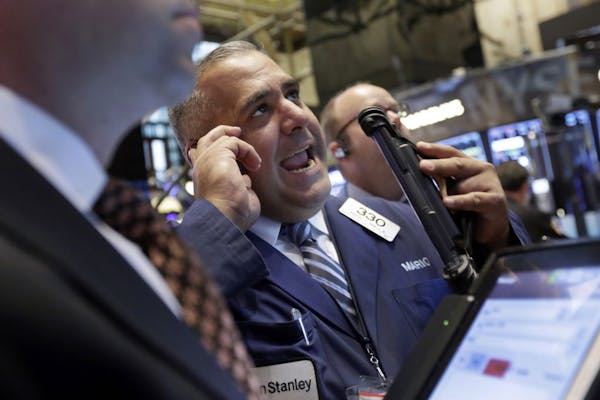NEW YORK - Investors in U.S. stocks have been arguing that a 10 percent decline of the S&P 500 was long overdue and a missing link of a healthy market. The benchmark index hasn't had a by-the-book correction in about four years.
Then the correction came and went. In a matter of five sessions, sentiment shifted dramatically on Wall Street and seemed to climax early on a volatile Monday, when the S&P fell as much as 12.5 percent from its record intraday high set last May, and the Dow Jones industrial average, fell 1,089 points shortly after the opening bell.
Within about 15 minutes, the Dow had retraced half of its plunge.
In mid-afternoon trading, major Wall Street indexes were still down more than 2 percent.
The strength of the rebound, in the face of an 8.5 percent overnight slide in Shanghai stocks and a 5.4 drop in Europe, has given support to views that the sharp early decline was more of a shakeout, a selloff exacerbated by automatic trading. Prevailing fundamentals have strategists and investors looking to pick up stocks rather that cut and run.
"We are unlikely to be going into a bear market," said Jason Ware, chief investment officer at Albion Financial Group, which manages about $1 billion for clients from Salt Lake City, Utah. "There are a number of positive things happening under the surface of all this chaos and it is easy to forget those things when you see these types of moves."
Ware and others pinned the early losses on what he called "indiscriminate selling" - automatic trading, forced selling to meet margin calls and the like.
Among positives he and others cited, the U.S. economy has been seen on strong enough footing to warrant a Federal Reserve interest rate increase, with many expecting one before the end of the year.
The S&P 500 earnings outlook improved as well: Second-quarter expectations now are for a 1.3 percent increase, sharply above the 3 percent decline expected at the start of last month.
"Over the course of the next couple of weeks we are going to get a number of data points that reinforce the U.S. economy is frankly in pretty good shape," said Phil Orlando, chief equity market strategist at Federated Investors in New York.
Graham Tanaka, president of Tanaka Capital Management and the TANAKA Growth Fund, said he is ready to go bottom-fishing. He had raised his cash level to approximately 10 percent of assets in recent months to be ready to buy on a dip like Monday's.
He is looking to add media companies such as Walt Disney Co., whose shares fell as much as 26 percent after posting earnings earlier this month.
"We missed it on its run last year in all honesty," Tanaka said. Disney shares were just above $98 after dropping to $90, their lowest since November, earlier on Monday.
Apple shares, among the most widely held on Wall Street, slumped almost 13 percent at the open but in afternoon trading were vacillating either side of flat on the day. CEO Tim Cook wrote in an email to CNBC that China business experienced "strong growth" in July and August, seeking to assuage investor concerns over the company's prospects in a market considered critical for its growth.
As dramatic as the rebound has been, however, few would dare say the market has set a bottom. The Fed has been hinting for months at a rate hike, which would be the first in almost a decade and could spook investors into more stock selling.
China's slowdown could be confirmed by more softening data, which likely would trigger further declines on Wall Street.
"The fundamental reasons why one owns stocks are unbroken. The (U.S.) economy and earnings are holding up," said Albion's Ware.
"That said it's the uncertainty that drives everyone crazy; because no one really knows."
